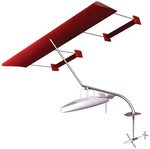Could this sailboat become the world's fastest?
 Engineering Engineering
University of Adelaide engineering students are building a marine vessel they hope will break the world sailboat speed record. The revolutionary craft - known as a wing-borne hydrofoil (WBHF) - is the first of its kind in the world. A team of final-year Mechanical Engineering students has been designing and building the first wing-borne hydrofoil sailing craft, based on the patented invention of an Adelaide mathematician and scientist, Stephen Bourn. "The hydrofoil will literally 'fly' more like a plane than a boat," said student team leader Luke Rogers. "There is a hull, but in place of a sail there is a wing, inclined and offset to the side, and in place of a keel there is a hydrofoil. The wing pulls the hull up to fly just above the waves smoothly, silently and incredibly fast." Students have completed the hydrofoil's designs and have begun manufacturing the craft. Extensive use of carbon fibre composite sandwich construction, with the latest vacuum resin infusion techniques, is helping to ensure high strength and minimum weight. Mr Rogers says when completed, the hydrofoil should sail more than twice as fast as the wind, break the world sailing speed record (currently 48.7 knots = 90.2 kph), become the "Formula One" vehicle of sailboat racing, and create a new extreme sport. Inventor Stephen Bourn said the design was inspired after a fresh look at the basic principles of sailing. "An exploration of the absolute limits to performance led to a revelation of a new fundamental 'law of motion' applicable to all sail craft," Mr Bourn said. "Paradoxically, in light to moderate winds, with the hull still in the water, the wing-borne hydrofoil will be just as fast but easier and safer to sail than the very quickest currently existing boats, because of inherent stability and self-righting properties." Mr Rogers said: "The most amazing thing about the wing-borne hydrofoil is that after working on the design we know it will work, even though at first sight it looks impossible." The students and the inventor have already secured a number of sponsors and are currently seeking further support to complete the project next year. "We'd like to be able to finish the vessel next year so we can challenge the world sailing speed record," Mr Rogers said. Story by David Ellis
|





